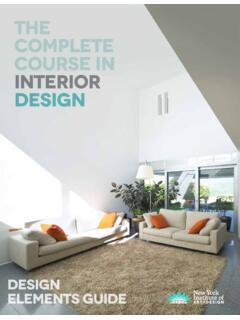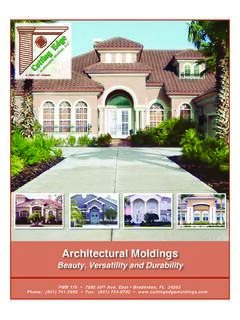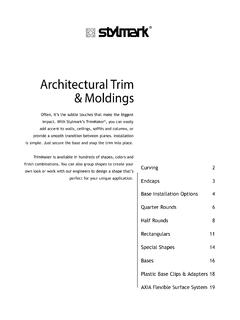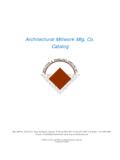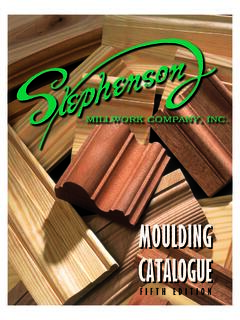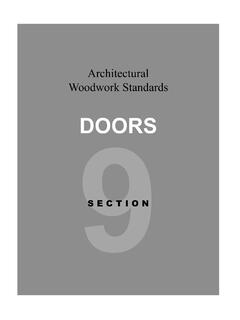Transcription of Architectural Elements - Buffalo Architecture Foundation
1 ARCHITECTURALELEMENTSBUILDINGSTRONGSHAPE S What is the strongest geometric shape? There are several shapes that are used when strength is important. The arc (think: circle) is the strongest structural shape, and in nature, the sphere is the strongest 3-d shape. The reason being is that stress is distributed equally along the arc instead of concentrating at any one silos, storage tanks, diving helmets, space helmets, gas tanks, bubbles, planets, etc. use cylinder or sphere shapes --or CIRCLEThe triangle is the strongest to as it holds it shape and has a base which is very strong a also has a strong support.
2 The triangle is common in all sorts of building supports and trusses. It is strong because the three legs of a triangle define one and only one triangle. If all three sides are made of rigid material, the angles are fixed and cannot get larger or smaller without breaking at the joints, unlike a rectangle, for example, which can turn into a parallelogram and even collapse totally. If you take a rectangle and place one diagonal piece from corner to corner, you can make that strong and stable, too, but doing that makes two triangles!! Think about it! so yes, it is the strongest shape THE TRIANGLEThe overall shape of many bridges is in the shape of a catenarycurve.
3 The catenarycurve is the strongest shape for an arch which supports only its own shape. Freely hanging cables naturally form a catenarycurve. THE CATENARY CURVEThe hexagon is the strongest shape known. Not many people know this but if you want something to hold a lot of weight pick a hexagon. Hexagonal patterns are prevalent in nature due to their efficiency. In a hexagonal grid each line is as short as it can possibly be if a large area is to be filled with the fewest number of hexagons. This means that honeycombs require less wax to construct and gain lots of strength under 's also one of the only shapes which tessellates perfectly (think tiles, if you tiled a wall with hexagons then there wouldn't be any gaps.)
4 THE HEXAGONSTRUCTURALELEMENTSArch a curvingstructure usedto span openingsin a wall: wedgeshaped pieces thatlean againsteach other Vault a continuous surface of semicircularor pointed sections; basically a seriesof arches set side-by-side forming a a system of support members that are heldrigid by utilizing a series of a small,support wall at a rightangle to another wall to counteract the outward thrust of a heavy roofor Buttress a buttresswith a non-structuralsection removedto give it the appearanceof a three dimensionalform based on a circle, the top of a dome is in compression while the bottom of a domeis in and Beam One of the earliest methods--of building.
5 It includes any structure built of vertical posts that hold up beams laid horizontally across Ring a ring holding its shape because itsmembers are in tension, pushing away from anupright (vertical) ORDERThe Elements of Classical ArchitectureAll classical Architecture of the Greco-Roman tradition is composed, or written, in one language of forms. These Elements of classical Architecture include specific Moldings and assemblages of moldings called an Order. * An Order is an accepted way of assembling a column (supporting element) with an entablature (spanning element) while imparting a certain character.
6 In short, an Order orders a design. Orders are never applied after the building is designed, as they are generative. Over time the canon has come to include five Orders: Tuscan, Doric, Ionic, Corinthian, and Composite. The Orders presented here represent the canon of the Roman tradition. THE5 CLASSICALORDERSNATURAL ELEMENTSBUILDINGSYSTEMS& BODYSYSTEMS How might our bodies compare to buildings? Do we have Elements that are similar to structural Elements of buildings?? Facade = Face Door = Mouth Windows = Eyes & Ears Exterior Walls = Skin Structural Framework = Skeleton Electrical System = Nervous System Plumbing System = Digestive & Excretory System Ventilation = Respiratory SystemBUILDINGSYSTEMS& BODYSYSTEMSKNOWLEDGE WORKALEXANDERGRAHAMBELL Who was Alexander Graham Bell?
7 What was he known for? What does he have to do with Architecture ?TETRAHEDRONSTHE TETRAHEDRAL KITE Invented by Alexander Graham Bell. Is a multicelledrigid box kite composed of tetrahedrallyshaped cells to create a kind of tetrahedral truss. The cells are usually arranged in such a way that the entire kite is also a regular tetrahedron. Bell found the tetrahedron to have a very good strength to weight ratio. Put more simply this means that an object is structurally very strong but at the same time very lightweight. Think Architecture --Metal girders and beams in most modern buildings are made of hollow steel beams.
8 What were they made of years ago?From an initial one cell model, Bell advanced to a 3,393 cell "Cygnet" model in 1907. This 40-foot long, 200 lbkite was towed by a steamer offshore near Baddeck, Nova Scotia on December 6, 1907 and carried a man 168 feet above the Each table will make (2) four cell kites. Within your table group divide yourselves into (2) groups of 4 people. Each person will be responsible for making 1 of the cells for the four cell kite. Instructions and supplies will be at your table. Creativity is always welcome! A & E Committee members will be available to assist if 1 STEP DIAGRAMSSTEP 3 STEP 4 STEP 7

